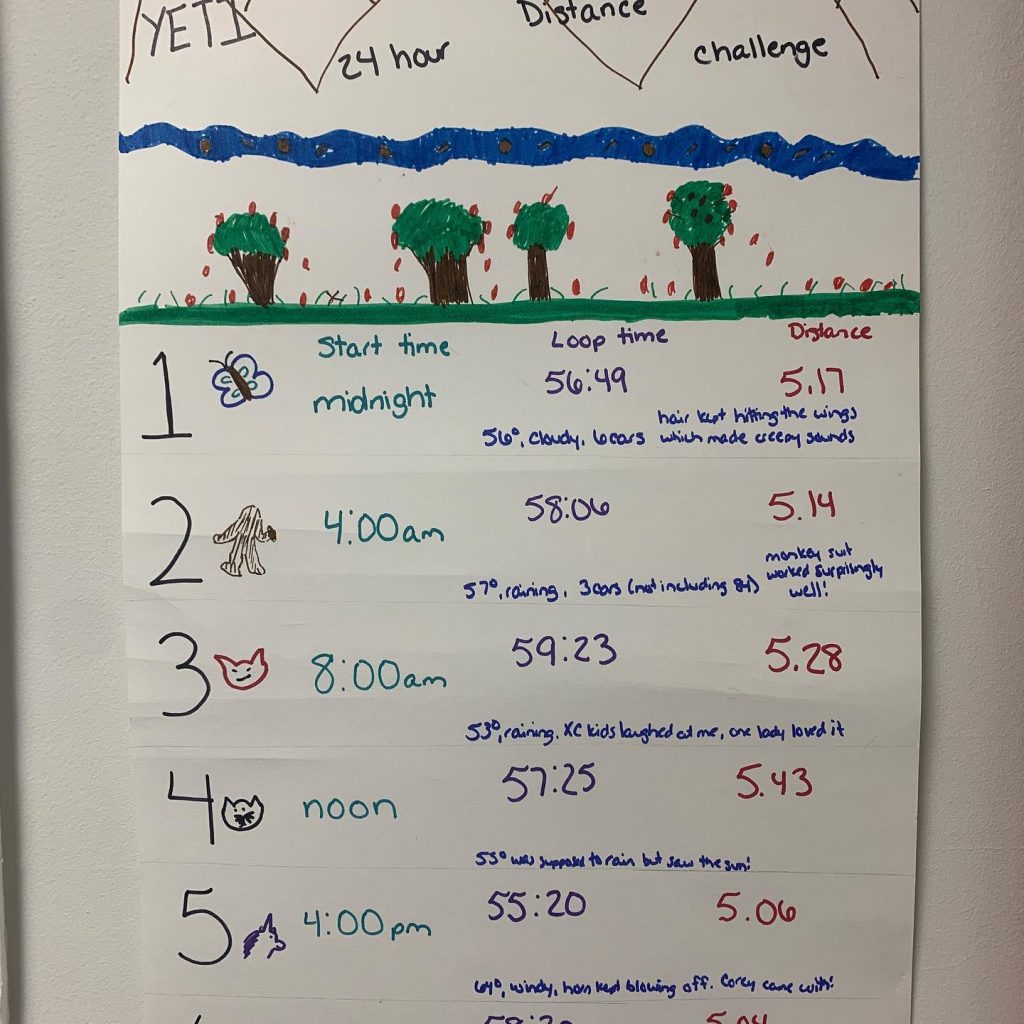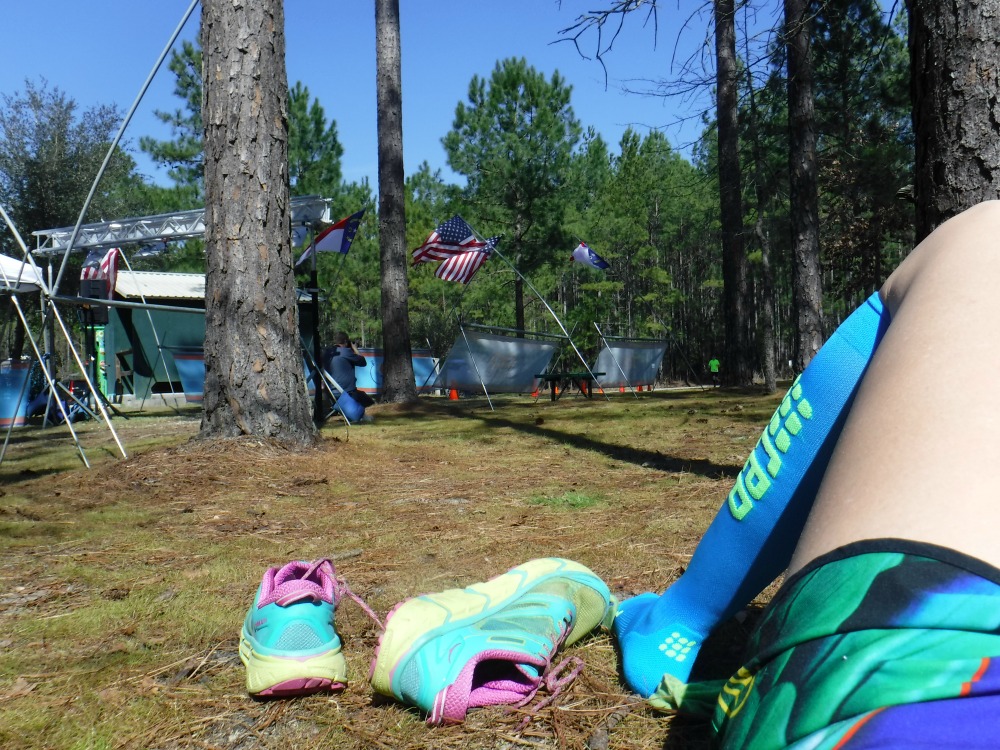Last Updated on January 22, 2022 by Heather Hart, ACSM EP, CSCS
During this uncertain time, with races canceled left and right, runners have taken to creating their own fun. Not to mention, race directors are stepping up their virtual race game. If you spend any time on social media whatsoever, you’ve probably seen fellow runners posting about their virtual 4x4x48 run, or the Yeti Challenge (5x4x24). You may be wondering exactly what these challenges are, and further, if you can successfully tackle one of them. As a coach to both running beginners and experienced ultrarunners alike, I have a few thoughts and tips. Let’s dive in:

What is the 4x4x48 / 5x4x24 Running Challenge?
Let’s talk about all of these numbers first, and what they mean:
4X4X48 Challenge
The 4x4x48 challenge includes running four miles at the top of every four hours, for 48 hours. This will result in running 48 total miles over the course of 48 hours. The 4x4x48 was inspired by retired Navy Seal and ultrarunner David Goggins. In the past, Goggins has described how he uses this workout to train for ultramarathons. Currently, you can find a number of virtual versions of this challenge to register for, or you can simply tackle it on your own.
Yeti Ultra 24 hour Challenge: 5X4X24
The Yeti Trail Runners, a trail running group based out of Georgia but known world wide in the ultra community, have challenged runners to their own version: The Yeti Ultra 24 Hour Challenge. This challenge requires you to run or walk 5 miles every 4 hours for 24 hours, for a grand total of 30 miles covered over 24 hours.

I’ve done some longer races – 30 miles – but never anything overnight because I really hate staying up all night and I hate the idea of sleeping in a van or something. Yeti sounded like the perfect way to balance a long distance challenge but still get that precious shut-eye. I also loved that it was something new. I know I can do 5 miles. I know I can do 5 miles twice in a day. But every four hours? ” – Amy Bushatz, host of the Humans Outside Podcast
Your Own Version:
The best part about these challenges is that they are virtual, and non competitive by nature. You only are up against yourself and your expectations. So if you want to modify…go for it! There’s no reason you can’t do a 4x4x12 hour, or a 2x4x24…or whatever combination of mileage and hourly intervals your heart desires.
Am I ready to run one of these challenges?
As an avid ultra runner also stuck at home with no starting lines in the foreseeable future, I completely understand the appeal of these challenges.
However, let me put on my coaching hat for a second.
Boredom aside, these are still some pretty heavy duty distances. Yes, you get a “break” between each run segment, but you are still covering 24-30 miles a day, depending on the challenge you choose. These sorts of distances can certainly do physical, structural damage if you aren’t properly trained for them.
Further, the physical stress and lack of sleep can potentially contribute to a decreased immune system. Right now really isn’t the time to make yourself more prone to becoming sick.
In short: I always tell my clients that I’ll never tell them they “can’t” do something, and that goes the same for my readers. But I will encourage you to look at your recent training, and truly contemplate the risk vs. reward on this one. If you’ve never run an ultra in your life, perhaps starting with 48 hours is not a wise decision. Consider modifying the distances in the challenge to better suit your current fitness levels. And remember: there is no shame in walking.
Before You Start:
Chances are you’ve got some time on your hands right now. So here’s a couple of things you should do before you start your challenge:
Come Up With a Plan
Make a chart to keep track of your intervals. It can be a simple spreadsheet, or an elaborate chart like the one below. Sure, early in the day it may be easy to remember that you have to run at 8 am, noon, 4 pm, etc. But once 4 am rolls around, I assure you: math gets harder. Write it all down, so you know when you are running.

Second, come up with a plan for what you will do before and after each run, such as filling water bottles, charging your GPS watch, or laying out your gear for the next leg. This will prevent you scrambling around going “oh sh*t I have to get back out there in two minutes! WHERE DID MY GARMIN GO?”
Lastly, decide where you’ll be running. Plot it out, whether it be on your treadmill or a local neighborhood loop. Know where you’re going to go, so you don’t have to do any mid-challenge navigation.
Rally Your “Support Crew”
Make sure the people in your inner-most circle (family, roommates, etc.) know what you are up to. If you are running outside during the overnight hours, it might not be a bad idea to have someone tag along for the run, or on a bike.
Don’t have a crew in person to help? Get yourself a virtual cheering squad! Even checking in with people virtually can be the accountability and encouragement you need to keep going when things get tough.
” Get a group or an accountability check in buddy! (Running friend) Ryan had organized Zoom check ins every 5(?) hours. So we would have one hour to complete the leg and then we would check in with each other. I skipped the night check ins, but it was honestly just nice knowing people were there doing the same weird thing I was. It also made me feel like I didn’t want to let them down. ” – Tanhee Lacey
Get Your Gear Ready
Unless you’re cool with sitting around in swampy running gear all day (and hey, I’m a dirtbag myself, I’m not judging) you’re going to want to plan out your gear. You’ll need multiple running outfits, or you’ll need a plan to hang yours to air out between legs. For your nighttime legs, you’ll want appropriate reflective gear and lights.
Running the Challenge:
Alright so we got the planning stages out of the way. Let’s get to the actual challenge, and what you need to know to be successful:
What Time of Day Should You Start the Challenge?
What time you start the challenge is completely up to you. I have one friend who started at midnight, because it was her birthday, and she wanted to complete the entire 24 hour challenge during her birthday. But if you’re asking for my opinion, I’ll tell you this: start in the morning.

Sure, it may seem like a good idea to start at night, so you can get the nighttime hours over with. But now you are exhausted while running at night (because your body is used to sleeping at these hours) AND you’ll be exhausted and sleep deprived while running the next day. Whereas, if you start in the morning after a full nights sleep, you’re going to have a great, rested day…and only feel the effects of sleep deprivation overnight.
” I thought I had timed it so I would just stay awake for the last run at 11:00pm, but I was exhausted. Having to pull myself out of bed when the alarm went off was one of the hardest things I have ever one. ” – Carol Plummer, Yeti Challenge Finisher and experienced ultra runner
How Fast Should You Run Each Leg?
Because it’s “only” four or five miles, you may be tempted to run faster than you would during a consistent 50K or 50 miler. However, a more conservative pace will help conserve muscle glycogen stores, and likely decrease or slow down the rate of damage to muscle tissue. Both are things you’ll definitely notice in the second half of your challenge.
“The hardest part was probably pacing myself. With each lap being “only” 5 miles, I definitely ended up going out too fast since I didn’t really consider the effect of cumulative mileage.” – Leah Barnes, Yeti Challenge finisher and experienced ultra runner
As mentioned earlier, there is zero shame in walking, whether it be timed walking intervals, or simply walking an entire 4/5 mile leg.
What to Do Between Legs:
So, you’ve got about three hours to kill between each leg. What should you do with your time?
Rest / Recover…but Move a little
It may be tempting to finish your run, hit the couch, and stay there for the next there hours. While some rest is definitely necessary, you want to avoid being completely sedentary between running legs. Gentle movement, such as walking around your house and light stretching will help promote blood flow to the muscles. Blood carries oxygen to help begin the recovery process, and helps remove built up waste products from damaged muscle. Sport specific compression socks or sleeves can also help with this process.

That said, mid challenge is not the time to tackle a huge house project or mow your lawn. Definitely rest when you can.
Nutrition and Hydration
Proper nutrition and hydration are absolutely integral for running for 24 – 48 hours. However, because you are only running 4-5 miles at a time, you may not think of fueling in the same way as you would for a continuous ultramarathon. Non the less: you’ve got to fuel.
You probably won’t want to eat large meals during your challenge. Instead, try incorporating healthy snacks in between each running leg. Listen to your hunger cues, but also refuel even if you aren’t hungry. You NEED those calories to jump start recovery AND to help keep you going.
“My best advice would be to sleep and rest when you can and to eat as soon as you can when you finish so you have time to digest. I stuck with all whole foods and felt really great for the whole thing ” – Rachel Goyette
Should You Sleep?
If you can sleep, then YES, you should. Especially during the 4x4x48 hour version of this challenge. Sleep is an imperative part of the recovery process. Plus, even short bursts of sleep will help you feel more mentally refreshed than staying up all night.
That said, I recognize that some people simply aren’t capable of sleeping in this manner. I’m a perpetual “non-napper” – it’s either all or nothing for me. If you can’t sleep, try to relax and put your feet up as best you can in the overnight hours between running legs. It’s still “rest”, and is beneficial for your body.
Overnight Concerns:
If you’ve never run during overnight hours before, you are in for a treat. Running late night or in the wee hours of the morning, when you are exhausted, is a shock to your system. You may find yourself experiencing anything from a much slower, stumbly pace, to more concerning things such as tunnel vision or hallucinations (specifically for those tackling the 48 hour challenges).

I struggled to make sure I rested enough between the runs. I was only able to nap a little before my last two at 11pm and 3 am. People had always told me that you needed to learn how to run on tired legs for Ultras. I only ended up running 27 miles but it was very hard to get going and keep going on the last few runs. – James McIlrath, 4x4x24 finisher
Point being, exhaustion levels can be an added risk when it comes to running at night. Slow down, pay attention to where you step (roots on trails or cracks in sidewalks can be your enemy), and use extra caution.
And of course, light yourself up. ESPECIALLY if you are running on roads. A reflective or light source on all of your appendages is your best bet: drivers are more likely to see a moving light/reflector on your arms or legs rather than a potentially stationary one on your chest/back
AFTER YOUR CHALLENGE:
So, you’ve finished your 5x4x24, your 4x4x48, or whatever mileage/time combination you came up with. If this was your first official ultra distance: congratulations!!
After your challenge, it’s imperative you focus on recovery. If this was your first overnight / sleepless event, you may be surprised to find your body and mind much more exhausted than you expected. Now is the time to focus on recovery.
Rest, catch up on sleep, eat nutritious foods, and hydrate well. Even though it was “only” four or five miles at a time, the cumulative effort combined with the lack of sleep certainly had some negative effects on your body. Don’t be surprised if it takes a few days or even a week or two to start to feel back to “normal”.
See also: How Long Should I Rest After an Ultramarathon?
Hooked on the Ultra Experience?
Us too! Check out my entire library full of ultramarathon tips and training plans for beginners. It’s constantly being updated, and I’m always happy to welcome new friends to the ultra-family!
Heather Hart is an ACSM certified Exercise Physiologist, NSCA Certified Strength and Conditioning Specialist (CSCS), UESCA certified Ultrarunning Coach, RRCA certified Running Coach, co-founder of Hart Strength and Endurance Coaching, and creator of this site, Relentless Forward Commotion. She is a mom of two teen boys, and has been running and racing distances of 5K to 100+ miles for over a decade. Heather has been writing and encouraging others to find a love for fitness and movement since 2009.

Dave Meltzer
I did the Yeti 5/4/24 in April tossing in a few extra miles as to hit a 50k in all. To that point my longest recent long run had been 12 miles. And I am 62, but a number of marathons and a few ultras completed as I started running late in life. I ran the first 5 legs but had to walk the final one as the hip and knee were screaming at me if I ran. I did a run walk method and tossed in a 3 min walk each mile and did ok. One has to WANT the golden ring here. If I can do it, most anyone can. 🙂
Simba Durio
Great tips, I’ll be incorporating several of these ideas. I can tell you the Goggins 4x4x48 is designed to make you suffer and test the limits of your physical and mental toughness. You’ll want to avoid injury, but make it hard enough to feel extremely proud when you’re done.